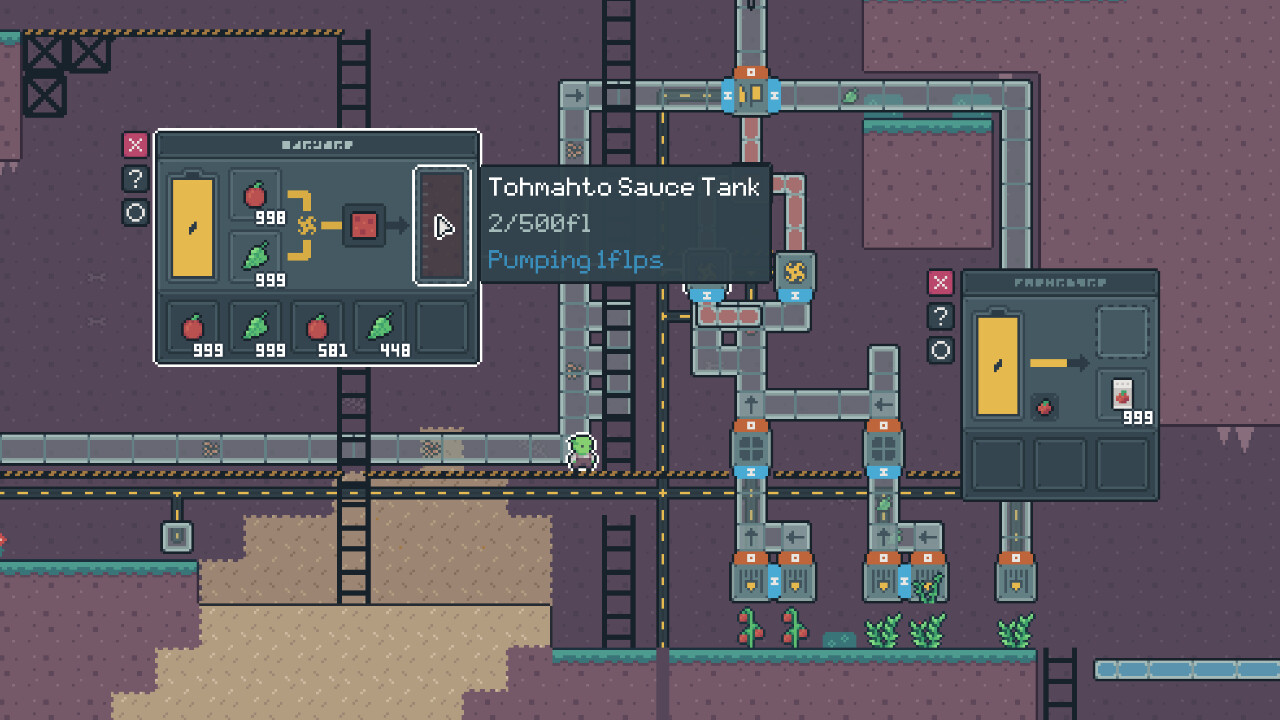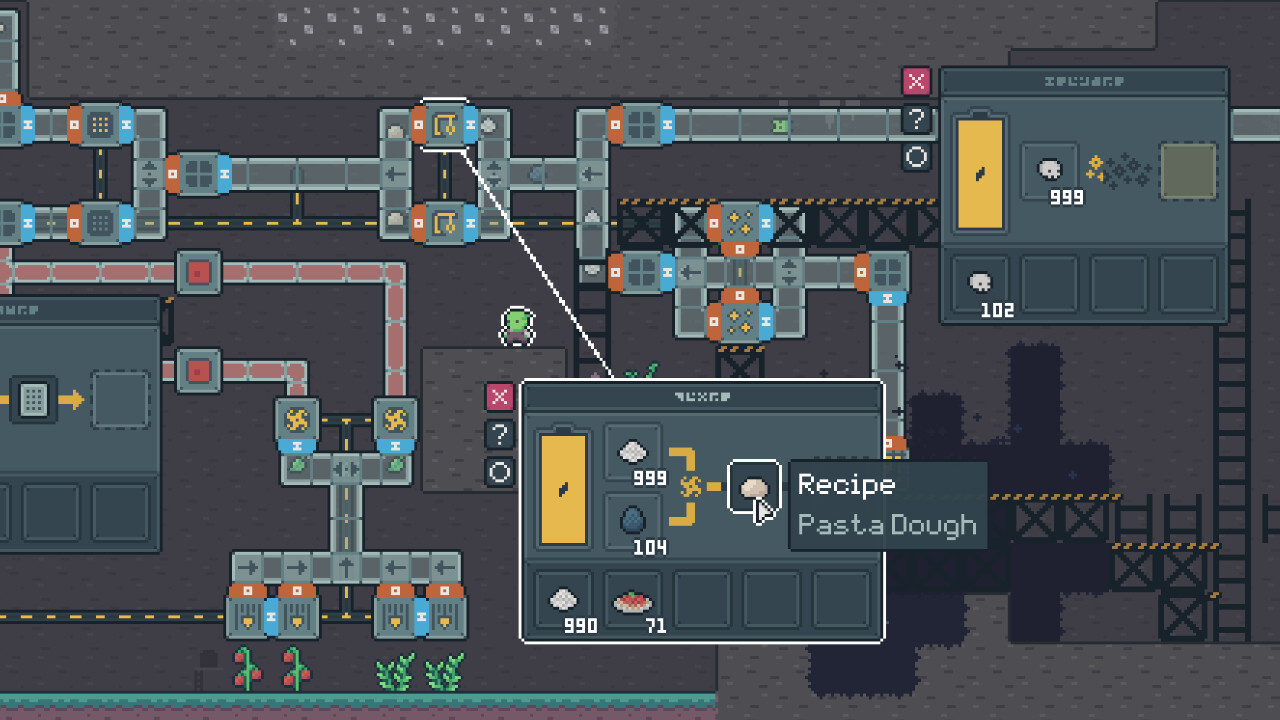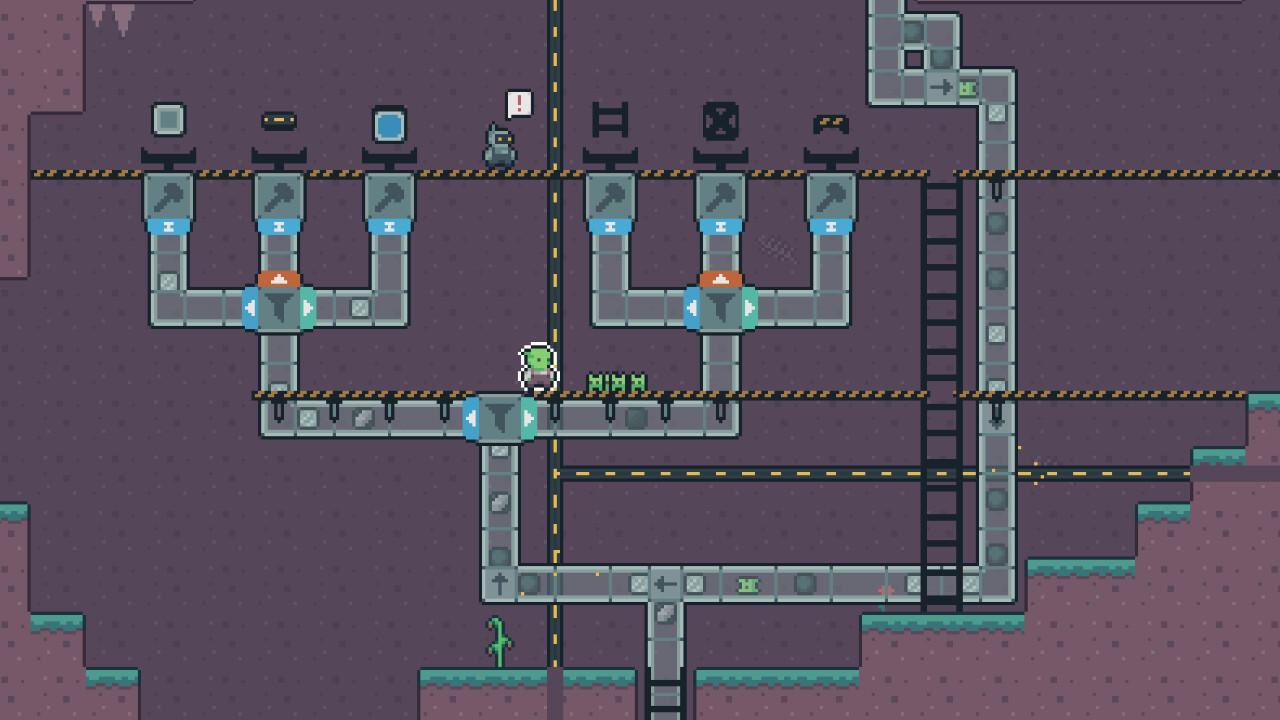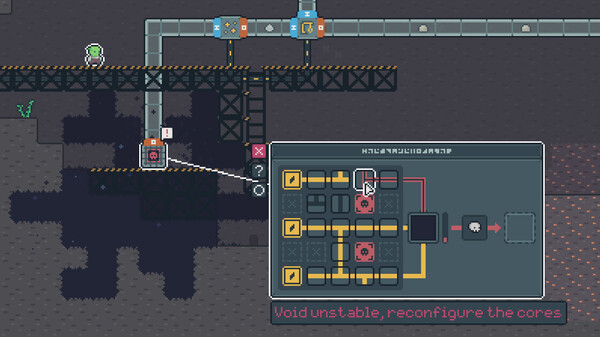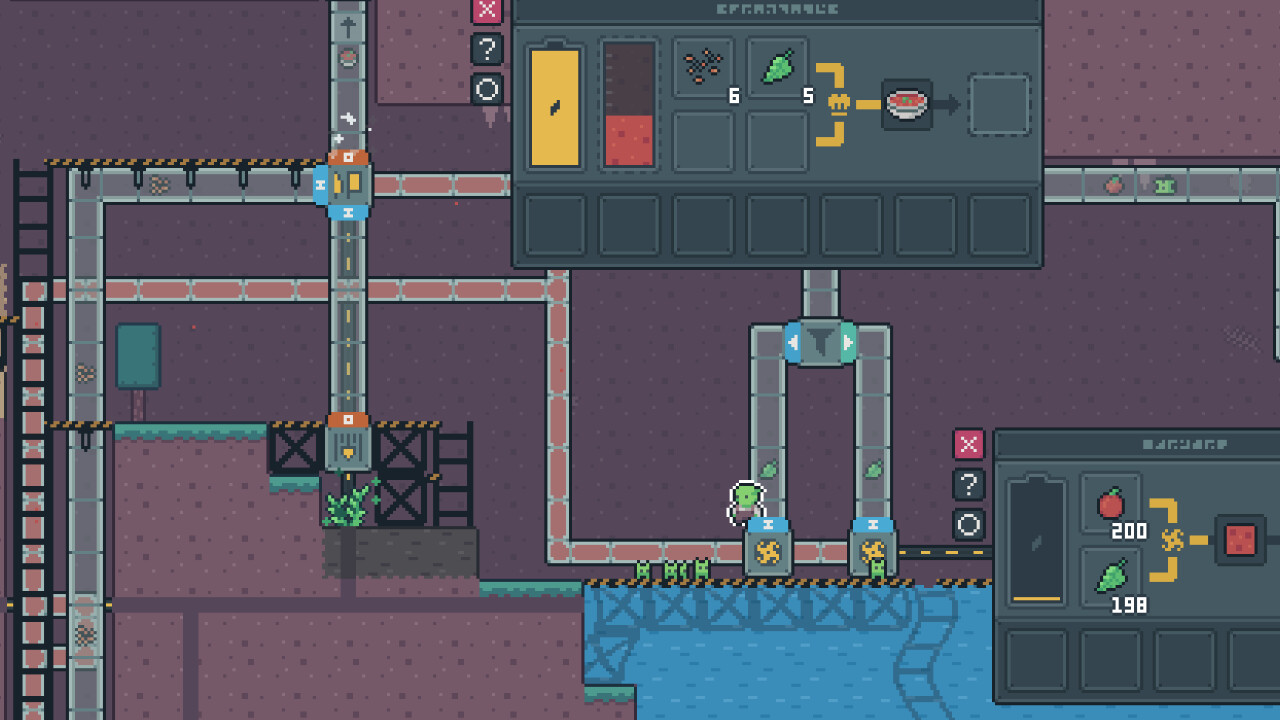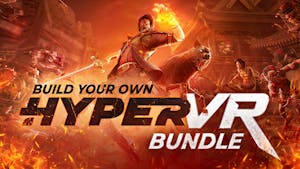
Snacktorio is a factory-cooking simulator where you must satisfy the appetites of unspeakable horrors... with food! Build and manage sprawling networks of machines & pipes to mass produce delicious meals that can satiate the endless hunger of the beasts that are invading your home. Order Up!
As one of the remaining chefs in your tribe, the responsibility of maintaining the balance with the monsters through the tasty medium of food has fallen on your grubby lil hands. Can you turn the tide on the ever growing threat of invasion, while proving your status as a Witchelin Star chef?

- Factory simulation in a 2D platforming setting
- Explore and mine for ores, resources, and spices
- Mass-produce food through automated cooking machines
- Take & fufill orders from all sorts of insatiable hangry beasts
- Build and manage networks of pipes to get ingredients where they need to be
- Experience all the stress of managing a restaurant without any of the pay!

This game is being created by indie dev duo TNgineers, (Ell and their brother Jamie), inspired by their love of factory simulation games.
They wanted to make something satisfyingly complex without using the same tired sci-fi theme for the genre, and dive into how different recipes could be made in interesting ways when using an RPG-esque setting.

If you want to follow along with the project you can catch us on Twitter, or hit up the TNgineers Discord, links are in the sidebar.
Clocking In - Devlog #5
Luckily nothing too bad broke when the game went live, so after a string of patches I was able to enjoy some time off without having to check my notifications every 5 minutes. Before I went though I had a catch-up with my brother, Jamie (metakitkat), to chat about Snacktorio.
The first thing we did was go through ALL the demo feedback since the new demo released in October 2023, and there was a lot, I think there was like 300+ submissions (thanks so much to all of you!)

I was a bit worried at first as that's a lot to get through, but as we went through them it ended up narrowing down to the same common gripes and suggestions, and some general game bugs.
Several sheets of paper later we'd got through everything, and I had a nice list of things to change and redesign before we got stuck in with the full game, including stuff like:
- reduced tools, so just hammer for destroying everything with left/right click modes, so that we could remove the pickaxe and the wirecutters, and only have 3 tools for everything needed
- redesigned blueprint menu to categorise all machines into 4 types so make things less cluttered and easier to find the one you need

- make imps less wack and have them teleport if they get stuck or too far from you
- be able to swap out utility blocks (scaffold/platform/ladders) without needing to hammer them
- a new 'Splitter' machine that lets you decide the volume of items in each direction (i.e. 2 up, then 1 left, then 3 down, then back around again)

Once we had got through all the feedback we then started discussing the full-game and the different mechanics we wanted to introduce as the game progressed through the mid to late game.
[hr][/hr]
- having certain ingredients 'age' or 'decay' if kept in pipes too long, i.e. eggs going bad, or cheese aging (sometimes good, sometimes bad)
- cross-contamination mechanics and having to manage items to prevent them touching or being in the same pipes
- ingredients that need to be kept cold by keeping the pipes cooled and avoiding heat sources like boiling oil
We already had a solid base, and for the level based system we're designing we had enough to fill the first island just from the demo's content alone, but with the additional mechanics we could plan out how to progress things across the other areas and make things increasingly complex and interesting.

We had decided on a level-based system a while back - it's probably in one of the older devlogs somewhere, but essentially we thought it'd be nicer to have a series of contained challenges rather than one huge world that you keep throughout the game and keep building on.
There's lots of little interesting mechanics or one-off puzzles we think would be fun but are not something you could drag out for a whole game, so having levels lets us do as much or as little as we want for a mechanic or a theme and then move on.
Plus with a level system we can introduce some challenges on top of what you've built when you beat the level initially - like a 'second helping' where the order rates increase and you have to expand what you already have.

I wanted the levels in distinct 'worlds' / 'islands', each with a focus on some base ingredient - we had a lot of options but settled on TOMATO > GARLIC > CHILLI as the main 3 big islands, with a few different seperate islands for some unique levels and recipes.

I didn't really want to have like 'Italian Island' or 'Mexican Island', I wanted the focus to more be on the ingredients used rather than the 'type' of food.
I think having one specific cuisine per island limits what we can do with it, vs say tomatos are used in so many different recipes around the world so we can have a lot of variety on the tomato island while keeping the core set of base ingredients the same.

With our rough plan ready to go, I then went and had my first holiday in over a year and tried not to think about work! (spoilers: I did)
When I came back in mid-May, I opened the code for the game for the first time since 2023 and waded in...
[hr][/hr]
Once I settled in the first thing I did was update the TNgine version Snacktorio was using (TNgine is the name for the light 'engine' I made with LVE that I make the games in). I originally made this engine for the Snacktorio demo, then used it to make Mudborne during which I made a few modifications. Mostly the changes were syntax based, although a few structures changed too.

Now I knew how the game worked again, and it was all in the same style as I'd been working in for the last year for Mudborne I could actually get started!
First thing I did was work through the main feedback we had from the demo, along with fix some of the bugs that were not specific to the demo and it's tutorial stuff. I then spent some time changing the save system so that each file slot was more linked to general progress, as with the level system we'd need saves per level per slot, rather than one big save per slot.

I then setup a temporary 'dev' world that I could use to quickly load levels. Each of the levels are designed in Tiled, and then exported to a .lua file that the game reads - however for the demo I'd done a few hardcoded things to make my life easier back then (that then made my life harder now).
With that done I could setup a level in Tiled, and if named correctly be able to reload the game and load the level, everything being reset properly. I did some placeholders for all the levels I'd roughly planned out (shown above), but I'm sure the number of levels per area will change as things develop! I just need _something_ as a base to get started.

With the level system working, I could get started on making levels! Honestly I'd say pretty much 80% of the rest of the game development is now making levels, and the rest will be coding in new mechanics and machines as needed.
The first thing we wanted to get designed though was a more in-depth tutorial, to make sure all the mechanics were taught in a fun and practical way.
[hr][/hr]
In the demo, the tutorial level works really well, and we'd had some lovely feedback from players. We then dump you right into a big order, followed by three MORE orders, which isn't quite the balance we want in the full-game but I think works fine for a demo.
For the full-game I wanted to break down the main parts of the demo tutorial and make them into their own levels to cover all the main mechanics:
- movement and placement / removal of blocks
- wires and power
- pipes and moving items/liquids around
- machines and imps
- making a full dinner

We also wanted a level that allowed players to skip all the tutorials - if they actually know what they're doing. For new players it should be hard enough that you couldn't just stumble across the solution, but for returning players they should be able to whizz through (and if not, back to the tutorial levels you go!)
As I designed the levels there were some little tweaks here and there, but mostly just around my own workflow and making it so I could specify more of the game logic from Tiled rather than have to hardcode a bunch of exceptions.

I actually really enjoyed designing the levels once things were all setup. I love designing the world of Mudborne but it was so big that it got so overwhelming to focus on the thing as a whole, here with distinct levels I could handle things much better.
I ended up with 5 tutorial levels designed, the final one being one that takes you through doing your first order and making you do all the stuff you'd just learned. I think they all do a good job on showing not telling, and make you do a lot of the stuff yourself which is the best way to learn really.

With those done I then designed the 'skip' level, which gives you no guidance and expects you to know what you're doing - along with knowing a few extra mechanics not yet introduced.
This way we can make sure players can't accidentally do this level too early before they even understand what they're doing. For those that do, completing this level marks all tutorial levels completed so you can just jump straight into the first island.

With that final level done the tutorial 'island' was complete, so all thats left is for me to draw a nice little overworld for it and then I can start designing the next island levels.
[hr][/hr]
At the time of writing I've started to plan out the tomato island levels but nothing really concrete yet - I want to get Jamie testing the new tutorial levels both as a player and a designer so that I can see if we need to tweak anything and if there's anything missing from the Tiled workflow that would make both our lives easier.
My plan is to make an updated demo for October so we can show all the new general changes, the tutorial island, and part of tomato island - I think that will then be a much better representation of the game and where it's going and we can move onto designing the rest of the game's levels!
~ Ell
Hey friends!
Been a little while since my last post - I took some time off and then started to get back into things by opening Snacktorio up for the first time in well over a year!
[hr][/hr]
Voice Of The People
After the release of Mudborne I spent the rest of March and most of April fixing and patching things - I had already planned to have a holiday at the end of April so I wanted to make sure everything was stable.Luckily nothing too bad broke when the game went live, so after a string of patches I was able to enjoy some time off without having to check my notifications every 5 minutes. Before I went though I had a catch-up with my brother, Jamie (metakitkat), to chat about Snacktorio.
The first thing we did was go through ALL the demo feedback since the new demo released in October 2023, and there was a lot, I think there was like 300+ submissions (thanks so much to all of you!)

I was a bit worried at first as that's a lot to get through, but as we went through them it ended up narrowing down to the same common gripes and suggestions, and some general game bugs.
Several sheets of paper later we'd got through everything, and I had a nice list of things to change and redesign before we got stuck in with the full game, including stuff like:
- reduced tools, so just hammer for destroying everything with left/right click modes, so that we could remove the pickaxe and the wirecutters, and only have 3 tools for everything needed
- redesigned blueprint menu to categorise all machines into 4 types so make things less cluttered and easier to find the one you need

- make imps less wack and have them teleport if they get stuck or too far from you
- be able to swap out utility blocks (scaffold/platform/ladders) without needing to hammer them
- a new 'Splitter' machine that lets you decide the volume of items in each direction (i.e. 2 up, then 1 left, then 3 down, then back around again)

Once we had got through all the feedback we then started discussing the full-game and the different mechanics we wanted to introduce as the game progressed through the mid to late game.
[hr][/hr]
What's New
There's some things I won't mention as I think they'll be more fun as a surprise, but some of the mechanics planned include ideas like:- having certain ingredients 'age' or 'decay' if kept in pipes too long, i.e. eggs going bad, or cheese aging (sometimes good, sometimes bad)
- cross-contamination mechanics and having to manage items to prevent them touching or being in the same pipes
- ingredients that need to be kept cold by keeping the pipes cooled and avoiding heat sources like boiling oil
We already had a solid base, and for the level based system we're designing we had enough to fill the first island just from the demo's content alone, but with the additional mechanics we could plan out how to progress things across the other areas and make things increasingly complex and interesting.

We had decided on a level-based system a while back - it's probably in one of the older devlogs somewhere, but essentially we thought it'd be nicer to have a series of contained challenges rather than one huge world that you keep throughout the game and keep building on.
There's lots of little interesting mechanics or one-off puzzles we think would be fun but are not something you could drag out for a whole game, so having levels lets us do as much or as little as we want for a mechanic or a theme and then move on.
Plus with a level system we can introduce some challenges on top of what you've built when you beat the level initially - like a 'second helping' where the order rates increase and you have to expand what you already have.

I wanted the levels in distinct 'worlds' / 'islands', each with a focus on some base ingredient - we had a lot of options but settled on TOMATO > GARLIC > CHILLI as the main 3 big islands, with a few different seperate islands for some unique levels and recipes.

I didn't really want to have like 'Italian Island' or 'Mexican Island', I wanted the focus to more be on the ingredients used rather than the 'type' of food.
I think having one specific cuisine per island limits what we can do with it, vs say tomatos are used in so many different recipes around the world so we can have a lot of variety on the tomato island while keeping the core set of base ingredients the same.

With our rough plan ready to go, I then went and had my first holiday in over a year and tried not to think about work! (spoilers: I did)
When I came back in mid-May, I opened the code for the game for the first time since 2023 and waded in...
[hr][/hr]
I Have No Memory Of This Place
Coming back to some old code can be tricky sometimes - you get into a specific headspace for that game while working on it, and know where everything is. Leaving for a couple years meant it took me a bit of time just to remind myself how this stupid game actually worked and where everything was.Once I settled in the first thing I did was update the TNgine version Snacktorio was using (TNgine is the name for the light 'engine' I made with LVE that I make the games in). I originally made this engine for the Snacktorio demo, then used it to make Mudborne during which I made a few modifications. Mostly the changes were syntax based, although a few structures changed too.

Now I knew how the game worked again, and it was all in the same style as I'd been working in for the last year for Mudborne I could actually get started!
First thing I did was work through the main feedback we had from the demo, along with fix some of the bugs that were not specific to the demo and it's tutorial stuff. I then spent some time changing the save system so that each file slot was more linked to general progress, as with the level system we'd need saves per level per slot, rather than one big save per slot.

I then setup a temporary 'dev' world that I could use to quickly load levels. Each of the levels are designed in Tiled, and then exported to a .lua file that the game reads - however for the demo I'd done a few hardcoded things to make my life easier back then (that then made my life harder now).
With that done I could setup a level in Tiled, and if named correctly be able to reload the game and load the level, everything being reset properly. I did some placeholders for all the levels I'd roughly planned out (shown above), but I'm sure the number of levels per area will change as things develop! I just need _something_ as a base to get started.

With the level system working, I could get started on making levels! Honestly I'd say pretty much 80% of the rest of the game development is now making levels, and the rest will be coding in new mechanics and machines as needed.
The first thing we wanted to get designed though was a more in-depth tutorial, to make sure all the mechanics were taught in a fun and practical way.
[hr][/hr]
Learning The Ropes
In the demo, the tutorial level works really well, and we'd had some lovely feedback from players. We then dump you right into a big order, followed by three MORE orders, which isn't quite the balance we want in the full-game but I think works fine for a demo.
For the full-game I wanted to break down the main parts of the demo tutorial and make them into their own levels to cover all the main mechanics:
- movement and placement / removal of blocks
- wires and power
- pipes and moving items/liquids around
- machines and imps
- making a full dinner

We also wanted a level that allowed players to skip all the tutorials - if they actually know what they're doing. For new players it should be hard enough that you couldn't just stumble across the solution, but for returning players they should be able to whizz through (and if not, back to the tutorial levels you go!)
As I designed the levels there were some little tweaks here and there, but mostly just around my own workflow and making it so I could specify more of the game logic from Tiled rather than have to hardcode a bunch of exceptions.

I actually really enjoyed designing the levels once things were all setup. I love designing the world of Mudborne but it was so big that it got so overwhelming to focus on the thing as a whole, here with distinct levels I could handle things much better.
I ended up with 5 tutorial levels designed, the final one being one that takes you through doing your first order and making you do all the stuff you'd just learned. I think they all do a good job on showing not telling, and make you do a lot of the stuff yourself which is the best way to learn really.

With those done I then designed the 'skip' level, which gives you no guidance and expects you to know what you're doing - along with knowing a few extra mechanics not yet introduced.
This way we can make sure players can't accidentally do this level too early before they even understand what they're doing. For those that do, completing this level marks all tutorial levels completed so you can just jump straight into the first island.

With that final level done the tutorial 'island' was complete, so all thats left is for me to draw a nice little overworld for it and then I can start designing the next island levels.
[hr][/hr]
At the time of writing I've started to plan out the tomato island levels but nothing really concrete yet - I want to get Jamie testing the new tutorial levels both as a player and a designer so that I can see if we need to tweak anything and if there's anything missing from the Tiled workflow that would make both our lives easier.
My plan is to make an updated demo for October so we can show all the new general changes, the tutorial island, and part of tomato island - I think that will then be a much better representation of the game and where it's going and we can move onto designing the rest of the game's levels!
~ Ell
[ 2025-06-30 10:26:35 CET ] [Original Post]
Minimum Setup
- OS: Ubuntu 20.04 LTS
- Processor: Intel Core i5 (4th Gen)Memory: 4 GB RAM
- Memory: 4 GB RAM
- Graphics: Intel HD Integrated
- Storage: 250 MB available space
GAMEBILLET
[ 6491 ]
GAMERSGATE
[ 2221 ]
MacGamestore
[ 1907 ]
FANATICAL BUNDLES
HUMBLE BUNDLES
by buying games/dlcs from affiliate links you are supporting tuxDB

